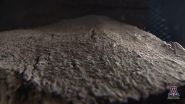(Press-News.org) Proteins inside a cell are in constant motion, changing shape continuously in order to carry out their functions. In addition, their multiple component atoms each have individual patterns of motion, making the entire protein a system of non-stop highly complex movement. Understanding how a protein moves is the key to developing drugs that can efficiently interact with it. But because of this complexity, protein motion has been notoriously difficult to study. Scientists at EPFL, IBS-Grenoble, and ENS-Lyon, have developed a new method for studying protein motion by first freezing proteins and then slowly "waking them up" with increasing temperature. The breakthrough method, which was developed at EPFL's advanced NMR facility, is published in Science.
Protein motion is highly complex
Motion is part of a protein's function, allowing it to adjust its 3D shape and interact with other molecules like biological molecules and synthetic drugs. These "functional" motions however are complex, and can be thought as the mechanism of a watch, where motions between interlocking cogs and springs, at different timescales, result in the smooth movement of the hands.
In a protein the cogs and springs are the molecules that make it up: amino acids form its backbone each with side-chains of different molecules branching out on all sides in three dimensions. In addition, water molecules on the protein as well as the solution where it exists, e.g. the cell's cytoplasm, add even more layers of motion complexity to the system. But unlike a watch, whose individual movements are all well defined, each of the component motions in a protein are actually random. As a result, protein motion seems almost chaotic, and is practically impossible to study.
Freeze, sleep, wake up, and move
A team of scientists at EPFL, IBS-Grenoble, and ENS-Lyon led by Lyndon Emsley and Martin Blackledge developed an innovative solution to the motion problem: freeze the proteins and then watch them "wake up" from deep sleep. Protein motion depends on energy, and temperature is basically a measurement of the energy of a system. By freezing proteins down to temperatures of -168°C, the researchers were able to completely stop all the motions of interest in the molecules. Then, they slowly raised the temperature to the point where the proteins could regain their natural motions, but at a much slower pace. This way, it was possible to look at each motion a protein makes individually and - more importantly - in sequence.
In order to detect the individual motions of proteins, the scientists used a spectroscopic technique called nuclear magnetic resonance (NMR), which exploits the magnetic properties of certain atoms like hydrogen and carbon. NMR works by placing the sample of the protein to be studied inside a device with a strong magnetic field, and observing how they respond to different radio frequencies. This response is registered on a computer that produces a diagram of peaks, each representing energy transitions in specific atoms. Depending on the properties of the peaks on the diagram, scientists can determine the degree of motion of each atom in the protein, e.g. its backbone, a side-chain etc.
Because the proteins in this study needed to be frozen down, the team had to adjust their NMR methodology to work with samples at very low temperatures, and keep doing so as the researchers slowly raised the temperature to "wake the proteins up". In addition, samples that are frozen solid are difficult to read in NMR, so the tube containing the proteins had to also be constantly spinning at a specific ("magic") angle to the NMR's magnetic field, to improve resolution. Finally, every NMR experiment took days to perform.
These complications were overcome by using a newly developed device that had been specifically designed to work with NMR at low and changing temperatures. To achieve the necessary high resolution, the scientists combined this device with a precise rotor system that could spin the sample over long periods of time.
A hierarchy of motion
Using their innovative approach, Emsley's team found that the sequence of protein motions follows a specific hierarchy as temperature increases: first the protein's solvent molecules, then the protein's side-chains and water molecules, and finally the protein's backbone. The sequence culminates with a functionally active protein at temperatures even as low as -53°C, well below physiological levels. This means that the "waking up" method is very effective for studying the motions of a protein individually and sequentially.
"Our work shows that we can use this technique, which is called 'variable-temperature solid-state NMR', to gain unique and novel insights into the role of protein dynamics in biology," says Lyndon Emsley. The team is now interested in using this method to find out just how universal this hierarchy of motions is, and what might cause variations between different molecules.
INFORMATION:
This work represents a collaboration of EPFL's Laboratory of Magnetic Resonance with ENS-Lyon and the CEA/CNRS at University of Grenoble Alpes.
Reference
Lewandowski J.R, Halse ME, Blackledge M, Emsley, L. Direct observation of hierarchical protein dynamics. Science 01 May 2015.
The fossil record helps to predict which kinds of animals are more likely to go extinct. When combined with information about hotspots of human impacts and climate-change predictions, Smithsonian scientists and colleagues pinpoint animal groups and geographic areas of highest concern for marine conservation in the May 1 issue of Science magazine.
"Just as some groups of people are more prone to health problems like diabetes or heart disease, we can tell from the fossil record which groups of animals are naturally more likely to go extinct," said Aaron O'Dea, paleontologist ...
If you thought that a beetle with a machine gun built into its rear end was something that only exists in sci-fi movies, you should talk to Wendy Moore at the University of Arizona.
Many beetles secrete foul-smelling or bad-tasting chemicals from their abdomens to ward off predators, but bombardier beetles take it a step further. When threatened, they combine chemicals in an explosive chemical reaction chamber in their abdomen to simultaneously synthesize, heat and propel their defensive load as a boiling hot spray, complete with "gun smoke." They can even precisely ...
SEATTLE, Wash. -- More than 1000 dams have been removed across the United States because of safety concerns, sediment buildup, inefficiency or having otherwise outlived usefulness. A paper published today in Science finds that rivers are resilient and respond relatively quickly after a dam is removed.
"The apparent success of dam removal as a means of river restoration is reflected in the increasing number of dams coming down, more than 1,000 in the last 40 years," said lead author of the study Jim O'Connor, geologist with the U.S. Geological Survey. "Rivers quickly erode ...
CAMBRIDGE, Mass--Bombardier beetles, which exist on every continent except Antarctica, have a pretty easy life. Virtually no other animals prey on them, because of one particularly effective defense mechanism: When disturbed or attacked, the beetles produce an internal chemical explosion in their abdomen and then expel a jet of boiling, irritating liquid toward their attackers.
Researchers had been baffled by the half-inch beetles' ability to produce this noxious spray while avoiding any physical damage. But now that conundrum has been solved, thanks to research by a ...
The vivid pigmentation of zebras, the massive jaws of sharks, the fight or flight instinct and the diverse beaks of Darwin's finches. These and other remarkable features of the world's vertebrates stem from a small group of powerful cells, called neural crest cells, but little is known about their origin.
Now Northwestern University scientists propose a new model for how neural crest cells, and thus vertebrates, arose more than 500 million years ago.
The researchers report that, unlike other early embryonic cells that have their potential progressively restricted as ...
ORANGE, Calif. - Researchers in Chapman University's Argyros School of Business and Economics and their collaborators have just published a study on the evolution of yoga in the marketplace. Assistant Professor Gokcen Coskuner-Balli, Ph.D., co-authored the study, which examined how the meaning of yoga transformed in the past three decades. The results show that yoga became decreasingly associated with spirituality and increasingly associated with medicine and fitness. The study argues that the shift in the meanings are due to the changes in how yoga gurus are trained, market ...
Flowering plants, also known as angiosperms, add an allure to the world that is unlike anything else in nature, but more importantly, they sustain us. Most of the fruits, vegetables, grains, beans, nuts, and even herbs and spices that we consume are produced by flowering plants. They all belong to the green plant branch of the tree of life, and a novel DNA analysis software program named MarkerMiner facilitates identification of genes that can be used to elucidate the evolutionary relationships between them.
University of Florida (UF) biologist Srikar Chamala, working ...
Over the past 35 years, California's high-wage workers have seen steady increases in their paychecks. But low-wage workers, 4.8 million strong and about one-third of the state's workforce, earned less in inflation-adjusted dollars in 2014 than they did in 1979, according to an analysis from the University of California, Berkeley.
UC Berkeley researchers analyzing U.S. Census Bureau data at the campus's Center for Labor Research and Education found that low-wage workers, defined as those earning hourly wages of $13.63 or less, have seen steady declines in their inflation-adjusted ...
As the number of bills passed by Congress declines, fewer and fewer Congressional representatives are voting across party lines, leaving only a few key representatives as collaborative voters, according to researchers.
"We can't say for sure that the decline in cooperation is the sole reason that there are fewer bills being introduced or passed by Congress, but we do know the two are statistically correlated, and both have been dropping steadily over the past 60 years," said Clio Andris, lead author and assistant professor of geography at Penn State.
The researchers ...
China's government and other sources say that the country's carbon-dioxide emissions flattened out between 2013 and 2014. The leveling-off was a remarkable feat that could set the country on a course to beating its own goals for lowering emissions. But this optimistic outcome hinges on China overcoming some serious energy challenges, according to an article in Chemical & Engineering News (C&EN), the weekly newsmagazine of the American Chemical Society.
Steven Gibb, a senior editor at C&EN, reports that a number of factors could help explain the emissions plateau. China ...

